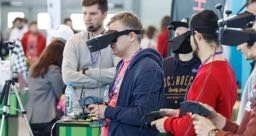Eastwind at DUMP-2019


For nine hours, the Yekaterinburg EXPO Center became a high-tech microcosm and a ground-zero of passionate debates featuring 1,500 technical minds – programmers, analysts, testers, managers and UX designers.
In what looked like an adaptation of some sci-fi classic, the IT village was divided into eight skill-based conglomerations – Backend, Frontend, Design, Management, Testing QA, Science, DevOps, and Mobile. Frontpersons from leading companies were pumping terabytes of data into the space at each of the locations non-stop: they shared scientific knowledge and real-life cases, and encouraged argument, which in turn sparked practical interactivities.

The participants migrated freely from spot to spot, adding to personal databases at lectures, pumping over at workshops, picking up insights for current projects, and filling on the best practices of top experts from Yandex, Naumen, Jet Style, HTML Academy, Web Standards, UralJS, Contour, Byndysoft, etc.
For Eastwind people, the conference is rock-solid on the annual schedule of events. There are few professional get-togethers where you can adopt and integrate expertise on such a scale. For Eastwind Big Data analyst Stepan Martyugin, is not the first DUMP, as he is attentive to trends. “Obviously, the demand for analytics is growing. This year, there are twice as many reports on Big Data, machine learning specifically, as compared with the last year’s event. Almost all the presentations in the Science section dealt with Big Data one way or another. The trend has it that traditional machine learning is getting deeper. Development times get shorter, and the complexity and amount of data for training are reduced,” he says.
Malika Lutfullaeva, data scientist at Eastwind, listened to several speakers at Science to find evidence that her current working approach is efficient.
“Nowadays, it is popular to use complex algorithms such as artificial intelligence and neural networks. But in practice, in 50 percent of cases, the developer can do with simpler tools,” she shares a qualified observation. “When I was working on a recommender for a chain of stores, I started with the classical methods such as the singular decomposition of matrices and finding the cosine distance. But they did not do as well as the statistical analysis of the frequency of purchases. In that case, hands-on practice determined the approach. So, a complex problem can often be solved in a simpler way. Here at the conference, I discovered that many developers have come to the same conclusions.”
Among her favorites at the conference, Malika named the research on the integration of Big Data into modern medicine by the head of the laboratory for biological system modeling at Moscow Technical University and Gero’s scientific director Peter Fedichev, and the report by Oleg Bartunov, CEO of Postgres Professional, on how IT help solve the greatest challenges of humanity, on the example of astronomy.
“I was fascinated to learn about the discoveries in the supergiant elliptical galaxy Messier 87 in the Virgo cluster, 16.4 parsecs from Earth, and how scientists solve massive data problems,” says Vilena Alexandrova, developer from Eastwind’s service app department, who also listened to Bartunov’s speech. “Scientists have confirmed Einstein’s relativity near a supermassive black hole.”

In order to see the event horizon of the black hole, the existence of which was predicted back in the 80s, astronomers used eleven powerful radio telescopes located in different parts of the planet, special matrices and gel disks to maintain antifreeze agent at a high altitude. The observation yielded petabytes of raw data to be stored in XLDB (eXtremely Large Data Bases).
At Backend, Vilena visited the reports of two engineers from Evil Martians. Dmitry Tsepelev explained to the audience “How to think graphs, or why GraphQL is not just a representation of a database structure” and compared it with JSON, and Sergey Dolganov spoke about “The contractual approach to designing APIs of dependent applications”. Yuri Kerbitskov, developer of Ak Bars Digital Technologies, helped to understand better what is under the hood of .NET Core, in his “.NET Core Application Domains” presentation.
To Eastwind interface developer Lev Shikhov, a well-organized and precise organization of the Urals DUMP reminded of Moscow’s Highload 2016. He and his frontend colleague Andrei Safronov particularly liked the speech and master class about reactive programming by the Frontend cluster leader Vitaly Dmitriev, of 404 Group. “In our practice, we are faced with similar tasks, and Dmitry proved that they are best solved using the reactive approach. Comparing frameworks for mobile development was really useful, and the bit about Angular Elements reaffirmed our intuition that, at least in our case, we can save time if we simply ignore the technology,” Lev Shikhov concludes.
“As for the frontend-developed mobile apps, I personally liked the presentation “React Native vs Cordova” by Artem Kuzvesov – an alternative view of mobile development. I suddenly felt like making test projects to compare and find strengths and weaknesses,” adds Andrey Safronov.
Alexander Kuleshov, from EW mobile services development group, also found something to add to his professional toolbox: he tested Vostok Herkules to monitor and collect data from services, had a chance to experience the “voracity” of the ElasticSearc search engine, and found similarities between the fast Redis with the Streams-capability and the Apache Kafka message broker. “The main trend that I observe is the growing interest in Big Data. More people are trying to crank more data, and there is a high-load problem. That means processing tools and analytics have to improve constantly, which is exactly what we see happening now,” the programmer concludes.
While the audiences strained their neuronal synapses in the classrooms, the lobby felt traditionally laidback: you could wet your throat with post-apocalyptic cocktails, make selfies with cosplayers and taste some fiery experience.
The show must go on.
Photos courtesy of DUMP IT-people.
